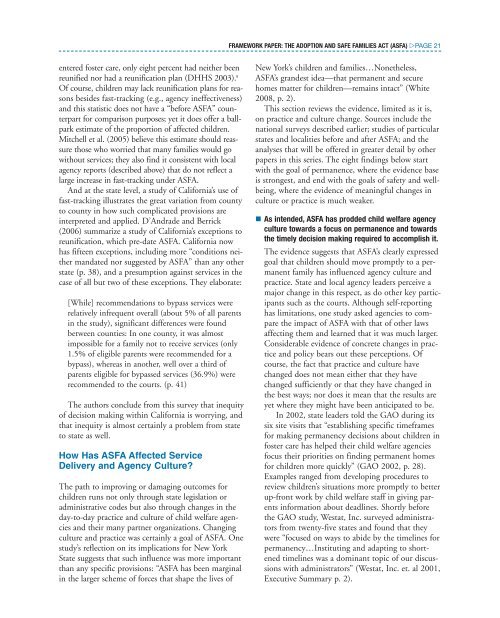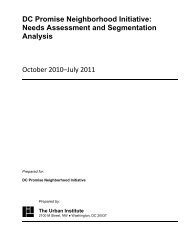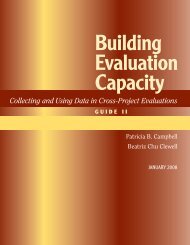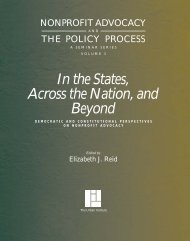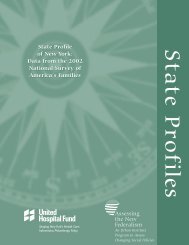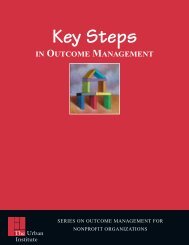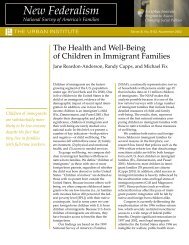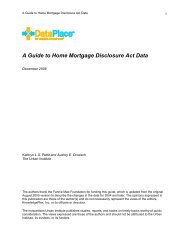Intentions and Results: A Look Back at the Adoption ... - Urban Institute
Intentions and Results: A Look Back at the Adoption ... - Urban Institute
Intentions and Results: A Look Back at the Adoption ... - Urban Institute
You also want an ePaper? Increase the reach of your titles
YUMPU automatically turns print PDFs into web optimized ePapers that Google loves.
entered foster care, only eight percent had nei<strong>the</strong>r been<br />
reunified nor had a reunific<strong>at</strong>ion plan (DHHS 2003). 8<br />
Of course, children may lack reunific<strong>at</strong>ion plans for reasons<br />
besides fast-tracking (e.g., agency ineffectiveness)<br />
<strong>and</strong> this st<strong>at</strong>istic does not have a “before ASFA” counterpart<br />
for comparison purposes; yet it does offer a ballpark<br />
estim<strong>at</strong>e of <strong>the</strong> proportion of affected children.<br />
Mitchell et al. (2005) believe this estim<strong>at</strong>e should reassure<br />
those who worried th<strong>at</strong> many families would go<br />
without services; <strong>the</strong>y also find it consistent with local<br />
agency reports (described above) th<strong>at</strong> do not reflect a<br />
large increase in fast-tracking under ASFA.<br />
And <strong>at</strong> <strong>the</strong> st<strong>at</strong>e level, a study of California’s use of<br />
fast-tracking illustr<strong>at</strong>es <strong>the</strong> gre<strong>at</strong> vari<strong>at</strong>ion from county<br />
to county in how such complic<strong>at</strong>ed provisions are<br />
interpreted <strong>and</strong> applied. D’Andrade <strong>and</strong> Berrick<br />
(2006) summarize a study of California’s exceptions to<br />
reunific<strong>at</strong>ion, which pre-d<strong>at</strong>e ASFA. California now<br />
has fifteen exceptions, including more “conditions nei<strong>the</strong>r<br />
m<strong>and</strong><strong>at</strong>ed nor suggested by ASFA” than any o<strong>the</strong>r<br />
st<strong>at</strong>e (p. 38), <strong>and</strong> a presumption against services in <strong>the</strong><br />
case of all but two of <strong>the</strong>se exceptions. They elabor<strong>at</strong>e:<br />
[While] recommend<strong>at</strong>ions to bypass services were<br />
rel<strong>at</strong>ively infrequent overall (about 5% of all parents<br />
in <strong>the</strong> study), significant differences were found<br />
between counties: In one county, it was almost<br />
impossible for a family not to receive services (only<br />
1.5% of eligible parents were recommended for a<br />
bypass), whereas in ano<strong>the</strong>r, well over a third of<br />
parents eligible for bypassed services (36.9%) were<br />
recommended to <strong>the</strong> courts. (p. 41)<br />
The authors conclude from this survey th<strong>at</strong> inequity<br />
of decision making within California is worrying, <strong>and</strong><br />
th<strong>at</strong> inequity is almost certainly a problem from st<strong>at</strong>e<br />
to st<strong>at</strong>e as well.<br />
How Has ASFA Affected Service<br />
Delivery <strong>and</strong> Agency Culture?<br />
The p<strong>at</strong>h to improving or damaging outcomes for<br />
children runs not only through st<strong>at</strong>e legisl<strong>at</strong>ion or<br />
administr<strong>at</strong>ive codes but also through changes in <strong>the</strong><br />
day-to-day practice <strong>and</strong> culture of child welfare agencies<br />
<strong>and</strong> <strong>the</strong>ir many partner organiz<strong>at</strong>ions. Changing<br />
culture <strong>and</strong> practice was certainly a goal of ASFA. One<br />
study’s reflection on its implic<strong>at</strong>ions for New York<br />
St<strong>at</strong>e suggests th<strong>at</strong> such influence was more important<br />
than any specific provisions: “ASFA has been marginal<br />
in <strong>the</strong> larger scheme of forces th<strong>at</strong> shape <strong>the</strong> lives of<br />
FRAMEWORK PAPER: THE ADOPTION AND SAFE FAMILIES ACT (ASFA) �PAGE 21<br />
New York’s children <strong>and</strong> families…None<strong>the</strong>less,<br />
ASFA’s gr<strong>and</strong>est idea—th<strong>at</strong> permanent <strong>and</strong> secure<br />
homes m<strong>at</strong>ter for children—remains intact” (White<br />
2008, p. 2).<br />
This section reviews <strong>the</strong> evidence, limited as it is,<br />
on practice <strong>and</strong> culture change. Sources include <strong>the</strong><br />
n<strong>at</strong>ional surveys described earlier; studies of particular<br />
st<strong>at</strong>es <strong>and</strong> localities before <strong>and</strong> after ASFA; <strong>and</strong> <strong>the</strong><br />
analyses th<strong>at</strong> will be offered in gre<strong>at</strong>er detail by o<strong>the</strong>r<br />
papers in this series. The eight findings below start<br />
with <strong>the</strong> goal of permanence, where <strong>the</strong> evidence base<br />
is strongest, <strong>and</strong> end with <strong>the</strong> goals of safety <strong>and</strong> wellbeing,<br />
where <strong>the</strong> evidence of meaningful changes in<br />
culture or practice is much weaker.<br />
� As intended, ASFA has prodded child welfare agency<br />
culture towards a focus on permanence <strong>and</strong> towards<br />
<strong>the</strong> timely decision making required to accomplish it.<br />
The evidence suggests th<strong>at</strong> ASFA’s clearly expressed<br />
goal th<strong>at</strong> children should move promptly to a permanent<br />
family has influenced agency culture <strong>and</strong><br />
practice. St<strong>at</strong>e <strong>and</strong> local agency leaders perceive a<br />
major change in this respect, as do o<strong>the</strong>r key participants<br />
such as <strong>the</strong> courts. Although self-reporting<br />
has limit<strong>at</strong>ions, one study asked agencies to compare<br />
<strong>the</strong> impact of ASFA with th<strong>at</strong> of o<strong>the</strong>r laws<br />
affecting <strong>the</strong>m <strong>and</strong> learned th<strong>at</strong> it was much larger.<br />
Considerable evidence of concrete changes in practice<br />
<strong>and</strong> policy bears out <strong>the</strong>se perceptions. Of<br />
course, <strong>the</strong> fact th<strong>at</strong> practice <strong>and</strong> culture have<br />
changed does not mean ei<strong>the</strong>r th<strong>at</strong> <strong>the</strong>y have<br />
changed sufficiently or th<strong>at</strong> <strong>the</strong>y have changed in<br />
<strong>the</strong> best ways; nor does it mean th<strong>at</strong> <strong>the</strong> results are<br />
yet where <strong>the</strong>y might have been anticip<strong>at</strong>ed to be.<br />
In 2002, st<strong>at</strong>e leaders told <strong>the</strong> GAO during its<br />
six site visits th<strong>at</strong> “establishing specific timeframes<br />
for making permanency decisions about children in<br />
foster care has helped <strong>the</strong>ir child welfare agencies<br />
focus <strong>the</strong>ir priorities on finding permanent homes<br />
for children more quickly” (GAO 2002, p. 28).<br />
Examples ranged from developing procedures to<br />
review children’s situ<strong>at</strong>ions more promptly to better<br />
up-front work by child welfare staff in giving parents<br />
inform<strong>at</strong>ion about deadlines. Shortly before<br />
<strong>the</strong> GAO study, West<strong>at</strong>, Inc. surveyed administr<strong>at</strong>ors<br />
from twenty-five st<strong>at</strong>es <strong>and</strong> found th<strong>at</strong> <strong>the</strong>y<br />
were “focused on ways to abide by <strong>the</strong> timelines for<br />
permanency…Instituting <strong>and</strong> adapting to shortened<br />
timelines was a dominant topic of our discussions<br />
with administr<strong>at</strong>ors” (West<strong>at</strong>, Inc. et. al 2001,<br />
Executive Summary p. 2).


